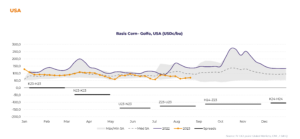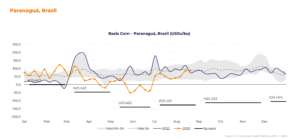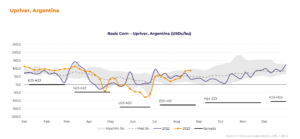What is Basis? We Explain the Concept to You!
Learn what basis is, which factors influence its calculation, and discover strategies for its application.
In the commodities market, the term “basis” refers to the difference between the physical price practiced in a specific local region and the price in the futures market for the same commodity. The future price is related to the asset’s price on the reference stock exchange, always based on the nearest maturity contract.
To help you understand, let’s use corn as an example. Suppose the physical price in the region of Sorriso, in the Brazilian state of Mato Grosso, is around R$ 75.00 per sack.
The quotation for the next contract for the same corn on B3, the acronym for the Brazilian stock exchange, is R$ 95.00. Here, the basis value will be negative R$ 20.00. When evaluating this value within a historical analysis, it’s possible to compare with averages from other years and identify whether the current market situation favors buying or selling.
In this text, we explain how the basis calculation is performed, which factors influence its price, and we present the two main strategies involving it.
Keep reading and find out more!
Basis: Understanding the Calculation
In local markets, the price of a commodity is adjusted according to the quotations practiced on stock exchanges and variables such as freight, handling, storage, quality, exchange rates, and supply and demand factors affecting that specific area.
The basis is calculated by subtracting the spot price of the commodity in the physical market of a specific local region from the price of the same product in the futures market, which can result in a positive or negative value. When it’s positive, it means that the product in the physical market has a higher spot value than in the futures market. In this case, it’s often referred to as a premium or a markup. If it’s negative, it’s called a discount or markdown.
Spot Price = Futures Price + Basis
If the trading is being done through futures contracts on the Chicago Board of Trade (CBOT), for example, the basis calculation should take into account the conversion of sacks into bushels (a unit of measurement used for trading grains on international exchanges).
Which Factors Influence Basis?
Basis can be influenced by four factors:
- Price curve of futures contracts for the commodity
The price curve of futures contracts reflects the balance between supply and demand. It’s a graphical representation showing the quotations of futures contracts for a commodity over different maturities.
This curve is an important tool for businesses involved in the global commodities chain, as it provides information about the market’s expectations regarding future commodity prices.
- Local supply and demand
For most agricultural commodities, there’s a seasonality in the volume produced. In the Southern Hemisphere, for example, periods of higher supply occur in the first half of the year. Therefore, we observe a weakening of the basis in countries like Brazil, as the future market price grows more than the spot price.
In the second half of the year, a more significant supply is identified in the Northern Hemisphere, a period when the basis in South America strengthens due to a smaller locally offered volume. Thus, the spot price grows more than the future price.
In Brazilian regions with higher grain storage capacity, there’s the possibility of storing the product for sale when the local price is more attractive.
When there’s no storage capacity, producers are obliged to trade their product shortly after harvest. The excess supply during this period results in price pressure and a more pronounced seasonal curve of basis.
In the graphs below, you can see the variation of corn basis in Argentina, Brazil, and the United States, observing the difference in values according to the hemispheres.



- Exchange Rate
It constitutes an influencing factor in the commodities basis for those that have their price referenced in foreign exchanges, such as soybeans and corn. In these cases, a strengthening of the exchange rate could result in a weakening of the basis in the Brazilian local markets. Conversely, a stronger local currency exchange rate tends to strengthen the basis in local markets.
- Transportation Logistics Costs
The logistical costs associated with transporting goods from the field to the export port are one of the main influencing factors in the basis. Port costs and other necessary fees for shipping the production must also be included in the calculation. The price attributed to the shipped product available for export is known as the Free on Board (FOB) price.
Basis-involved Strategies: Understanding the Concepts
The basis can be applied strategically in two ways to benefit traders:
- Long Basis Strategy (Basis Purchase): This strategy is based on the idea that the spot price of the commodity in the physical market will increase in relation to the price of futures contracts until their maturity. Thus, by implementing the long basis strategy, we position ourselves long (buyers) in the spot market and simultaneously short (sellers) in futures contracts for the commodity.
- Short Basis Strategy (Basis Sale): This strategy is usually based on the expectation that the commodity’s spot price in the physical market will decrease in relation to the price of futures contracts until their maturity. Therefore, it involves selling the physical commodity and buying futures contracts.
hEDGEpoint: Deep Understanding for Your Business
The basis is a rather complex subject influenced by various factors, both global and regional. Understanding this concept makes a significant difference in business.
hEDGEpoint deeply understands the commodities sector and the aspects that affect its dynamics. With market intelligence, data analysis, and the multidisciplinary knowledge of our team, we offer hedging tools to manage risks in this market.
Speak to a hEDGEpoint professional and learn how we can assist you.






